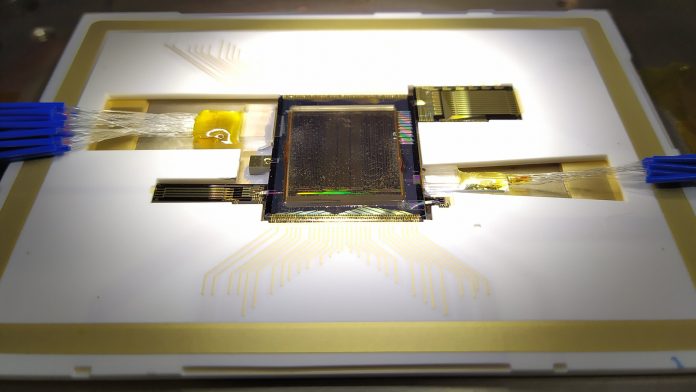The SPACEBEAM project has pioneered the exploitation of photonics for flexible and high-performing beamforming receivers for synthetic aperture radars.
Earth observation (EO) from space has been a key tool for decades in sectors like cartography and elevation mapping, and it is now becoming increasingly important in monitoring the environment to understand and mitigate the effects of global warming.
In general, the versatility of EO systems makes them suitable to continuously face the demand for increased performance, particularly in terms of resolution and sensitivity.
Spaceborne Synthetic Aperture Radars (SARs) are commonly used in EO, offering fine imaging resolution by processing sets of consecutive acquisitions recorded while flying over the targeted area. Although SARs are well-established, research continues to seek innovative techniques to improve their performance.
SCORE SAR systems
One such advanced technique developed as part of the SPACEBEAM project is the scan-on-receive (SCORE) mode. The SCORE-SAR paradigm overcomes a fundamental limitation of the conventional stripmap SAR, where the achievable spatial resolution along-track is inversely related to the swath width across-track and thus requesting multiple passes of the satellite to fully observe a given area with a high resolution.
The SCORE principle involves illuminating a wide swath in transmission and receiving the radar echoes through multiple smaller (i.e., higher-gain) receive beams steered across-track to cover the whole swath.
To date, there are no X-band SCORE SAR systems in orbit or planned. This is due to the limitations of digital electronics in enabling multi-channel, wide bandwidth, real-time digital beamforming (from few hundreds of MHz up to 1.2 GHz per channel) in terms of size, weight, power, and costs (SWaP-C), which prevents its applicability on board of small and micro-satellites.
To make the SCORE-SAR observation mode available for higher frequencies and smaller SAR missions, a compact and less power-hungry implementation of the beamforming is required.
Photonic technologies have already penetrated various satellite subsystems and functions, thanks to their broadband nature, insensitivity to electromagnetic interference (EMI), low loss, and data-transparent link capacity. In particular, microwave photonics (i.e., photonics applied to microwave systems) offer the possibility of easily performing frequency-agnostic operations to process radio frequency (RF) signals in any employed region of the RF spectrum.
The impressive advances in photonic integrated technologies are very promising in reducing the SWaP of microwave systems. Photonic integrated circuit (PIC) technologies have demonstrated the capability to implement beamforming networks (BFNs) for 5G communications and wideband radar systems.
This article describes the development and testing of the first photonics-assisted SCORE-SAR receiver module intended for EO from space. This activity has been carried out within the project SPACEBEAM: Space SAR system with reconfigurable integrated photonic beamforming, funded by the European Commission under the H2020 programme, Grant Agreement number 870421, which started in January 2020 and has just finished.
The consortium is made of Scuola Superiore Sant’Anna (Italy) co-ordinating the action, OHB System AG (Germany), Lionix International B.V. (Netherlands), Antwerp Space N.V. (Belgium), Tyndall National Institute (Ireland), and Astro- und Feinwerktechnik Adlershof GmbH (Germany).
The core of the system is an extremely compact hybrid PIC, realised thanks to the advanced integration of a Silicon Nitride (SiN) chip, including extremely low-loss passive components, with few Indium Phosphide (InP) chips for active and opto-electronic components. The hybrid PICs have been designed, realised, and assembled by Lionix.
The controls of the SiN PIC are implemented using piezo-electric actuators in lead zirconate titanate (PZT), a patented solution of Lionix with the fundamental feature of consuming negligible electrical power, which is of paramount importance in space applications.
As per the requirements expressed by OHB, the proposed SCORE-SAR photonics-assisted receiver is able to process 12 incoming RF signals in the optical domain, thanks to an analogue reconfigurable optical BFN capable of dynamically synthetising and steering three independent beams with continuity.
Simultaneously, the PIC also performs the down-conversion to intermediate frequency (IF) of the X-band signals received by the antenna elements. In terms of number of functions and of input/output ports (I/O), the SPACEBEAM project hybrid PIC is therefore the most challenging photonic integrated circuit developed to date.
SPACEBEAM receiver
The SPACEBEAM receiver has been developed into two versions. The first version is a functional model, developed by Lionix, in which the hybrid PIC has been provided with a fanout printed circuit board for easy interfacing, and with the control electronics. This version has been used for functional testing, as discussed below.
The second version is a hermetic packaged PIC, carried out by Tyndall and requested by the targeted space applications. The large number of RF I/O and controls have requested the identification of an alternative solution to the most common ‘goldbox’, which showed prohibitive complexities and costs. The identified solution is instead based on the ‘chiplet’ package, where a ceramic fanout board also works as a base for the metal cap, ensuring the hermeticity. It is relevant to note that the hermetic packaged PIC does not have I/O fibres, since the system performs a purely RF function.
Together with the hermetic packaged PIC, the driving electronics based on space-grade devices have also been designed by Antwerp Space. This activity has confirmed the availability of space-grade components suitable for driving the SPACEBEAM device in space. An accurate estimation of size, weight and power consumption has been done, showing that the volume of the entire SPACEBEAM receiver, including the driving electronics, should be less than 2.5l, and its weight in less than 4kg, whereas a SAR receiver built with conventional RF electronics and digital beamforming based on FPGA would require 20l and 25kg.
Moreover, the estimated power consumption is only 3.5W for the PIC alone (thanks to the low-consuming PZT actuators) and 65W (maximum rating) for the full receiver, including the electronics. The standard counterpart would request 120W.
Rigorous testing
The functional model is currently undergoing tests at Lionix and at Scuola Superiore Sant’Anna, and it has already demonstrated features such as the emission of a hybrid laser based on PZT actuators (first case for Lionix production, and one of the first in the world), and the down-conversion capability. The beamforming performance instead has not been tested yet; it will be done in the next few months.
Application in space also requires the SPACEBEAM project solution to be tested under harsh environmental conditions. Therefore, during the project, the functional model has been tested by Astro-und Feinwerktechnik against radiation and thermal cycling in vacuum. These tests have been run following the procedure defined by the European Space Agency. A series of reduced functional tests have been performed before, during and after the environmental tests, executed by Antwerp Space. These tests have shown that the hybrid PIC is unaffected by the space conditions.
The SPACEBEAM project has demonstrated that integrated photonics can implement a complex beamforming network with analogue precise control, ensuring a significant SWaP reduction in the harsh space environment. Moreover, the large bandwidth of photonic technologies allows addressing radars at higher frequencies (up to Ka band, 27-40GHz).
Therefore, the experience gained in the SPACEBEAM project is expected to facilitate several new opportunities in Earth observation applications based on integrated microwave photonics techniques.
 This project is supported by the European Union’s Horizon 2020 research and innovation programme under grant agreement No. 870421
This project is supported by the European Union’s Horizon 2020 research and innovation programme under grant agreement No. 870421
Please note, this article will also appear in the fifteenth edition of our quarterly publication.









